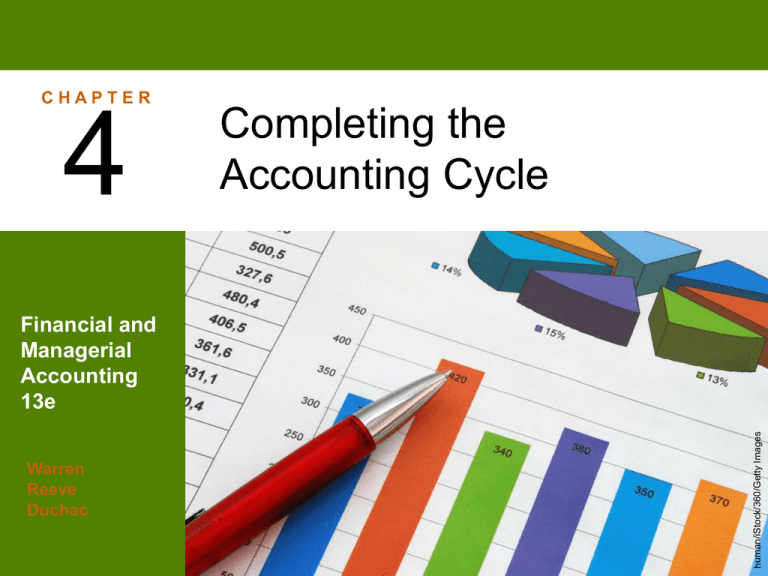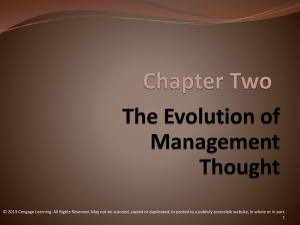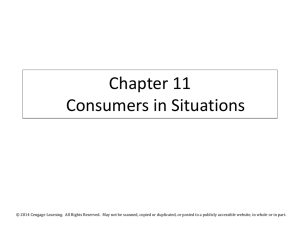
CHAPTER
4
Completing the
Accounting Cycle
Warren
Reeve
Duchac
human/iStock/360/Getty Images
Financial and
Managerial
Accounting
13e
Income Statement
•
•
The income statement is prepared directly from the
Adjusted Trial Balance columns of the end-of-period
spreadsheet (work sheet), beginning with fees earned
of $16,840.
The expenses in the income statement are listed in
order of size, beginning with the larger items.
However, Miscellaneous Expense is always the last
account listed, regardless of its amount.
©2016 Cengage Learning. All Rights Reserved. May not be scanned, copied or duplicated, or posted to a publicly accessible website, in whole or in part.
Retained Earnings Statement
•
•
The first item normally presented on the retained
earnings statement is the balance of the retained
earnings account at the beginning of the period.
Net income (or net loss) and the dividends account
balance are used to determine the ending retained
earnings account balance.
©2016 Cengage Learning. All Rights Reserved. May not be scanned, copied or duplicated, or posted to a publicly accessible website, in whole or in part.
Balance Sheet
•
•
The balance sheet is prepared directly from the
Adjusted Trial Balance columns of the end-of-period
spreadsheet, beginning with Cash of $2,065.
A classified balance sheet is a balance sheet that is
expanded by adding subsections for assets and
liabilities.
o
o
Assets are commonly divided into two sections on the
balance sheet: (1) current assets and (2) property, plant,
and equipment.
Liabilities are commonly divided into two sections on the
balance sheet: (1) current liabilities and (2) long-term
liabilities.
©2016 Cengage Learning. All Rights Reserved. May not be scanned, copied or duplicated, or posted to a publicly accessible website, in whole or in part.
Current Assets
(slide 1 of 2)
•
•
Cash and other assets that are expected to be
converted into cash or sold or used up usually within
one year or less, through the normal operations of the
business, are called current assets.
Current assets include:
o
o
o
o
o
Cash
Accounts receivable
Notes receivable
Supplies
Other prepaid expenses
©2016 Cengage Learning. All Rights Reserved. May not be scanned, copied or duplicated, or posted to a publicly accessible website, in whole or in part.
Current Assets
(slide 2 of 2)
•
•
Notes receivable are written promises by the
customer to pay the amount of the note and interest.
Like accounts receivable, notes receivable are
amounts that customers owe, but they are more formal
than accounts receivable.
Notes receivable and accounts receivable are current
assets because they are usually converted to cash
within one year or less.
©2016 Cengage Learning. All Rights Reserved. May not be scanned, copied or duplicated, or posted to a publicly accessible website, in whole or in part.
Property, Plant, and Equipment
•
Property, plant, and equipment (also called fixed
assets or plant assets) include land and assets that
depreciate over a period of time.
o
Assets that depreciate over time include:
Equipment
Machinery
Buildings
©2016 Cengage Learning. All Rights Reserved. May not be scanned, copied or duplicated, or posted to a publicly accessible website, in whole or in part.
Current Liabilities
•
•
Amounts the business owes to creditors that will be
due within a short time (usually one year or less) and
that are to be paid out of current assets are called
current liabilities.
Current liabilities include:
o
o
o
o
o
Accounts payable
Notes payable
Wages payable
Interest payable
Unearned fees
©2016 Cengage Learning. All Rights Reserved. May not be scanned, copied or duplicated, or posted to a publicly accessible website, in whole or in part.
Long-Term Liabilities
•
Amounts the business owes to creditors that will not be
due for a long time (usually more than one year) are
called long-term liabilities.
©2016 Cengage Learning. All Rights Reserved. May not be scanned, copied or duplicated, or posted to a publicly accessible website, in whole or in part.
Stockholders’ Equity
•
•
•
Stockholders’ equity is the stockholders’ right to the
assets of the business.
It is presented on the balance sheet below the
liabilities section.
Stockholders’ equity is added to the total liabilities,
and this total must be equal to the total assets.
©2016 Cengage Learning. All Rights Reserved. May not be scanned, copied or duplicated, or posted to a publicly accessible website, in whole or in part.
Permanent Accounts
•
•
•
Accounts that are relatively permanent from year to
year are called permanent accounts or real
accounts.
The balances of these accounts are carried forward
from year to year.
This includes accounts reported on the balance sheet.
©2016 Cengage Learning. All Rights Reserved. May not be scanned, copied or duplicated, or posted to a publicly accessible website, in whole or in part.
Temporary Accounts
•
•
•
Accounts that report amounts for only one period are
called temporary accounts or nominal accounts.
Temporary accounts are not carried forward from
year to year because they relate to only one period.
This includes all accounts reported on the income
statement as well as the dividends account, which is
reported on the retained earnings statement.
©2016 Cengage Learning. All Rights Reserved. May not be scanned, copied or duplicated, or posted to a publicly accessible website, in whole or in part.
Closing Entries
(slide 1 of 3)
•
•
•
•
To report amounts for only one period, temporary accounts
should have zero balances at the beginning of the next period.
To achieve this, temporary account balances are transferred to
permanent accounts at the end of the accounting period through
journal entries.
The entries that transfer these balances are called closing
entries. The transfer process is called the closing process and
is sometimes referred to as closing the books.
After the closing entries are posted, all of the temporary
accounts have zero balances.
©2016 Cengage Learning. All Rights Reserved. May not be scanned, copied or duplicated, or posted to a publicly accessible website, in whole or in part.
Closing Entries
(slide 2 of 3)
•
•
•
•
•
Income Summary is a temporary account that is only used
during the closing process.
At the beginning of the closing process, Income Summary has no
balance.
During the closing process, revenue and expense accounts are
cleared by debiting or crediting Income Summary for their
amounts. Because it has the effect of clearing the revenue and
expense accounts of their balances, Income Summary is
sometimes called a clearing account.
The balance of Income Summary (net income or net loss) is
transferred to the retained earnings account.
At the end of the closing process, the Income Summary account
will have a zero balance.
©2016 Cengage Learning. All Rights Reserved. May not be scanned, copied or duplicated, or posted to a publicly accessible website, in whole or in part.
Closing Entries
(slide 3 of 3)
•
The four closing entries required in the closing process are as
follows:
1. Debit each revenue account for its balance and credit
Income Summary for the total revenue.
2. Credit each expense account for its balance and debit
Income Summary for the total expenses.
3. Debit Income Summary for its balance (net income) and
credit the retained earnings account. (In the case of a net
loss, credit Income Summary for its balance and debit the
retained earnings account.)
4. Debit the retained earnings account for the balance of the
dividends account and credit the dividends account.
©2016 Cengage Learning. All Rights Reserved. May not be scanned, copied or duplicated, or posted to a publicly accessible website, in whole or in part.
Post-Closing Trial Balance
•
•
A post-closing trial balance is prepared after the
closing entries have been posted.
The purpose of the post-closing (after closing) trial
balance is to verify that the ledger is in balance at
the beginning of the next period.
©2016 Cengage Learning. All Rights Reserved. May not be scanned, copied or duplicated, or posted to a publicly accessible website, in whole or in part.
Accounting Cycle
•
•
The accounting process that begins with analyzing and
journalizing transactions and ends with the post-closing trial
balance is called the accounting cycle.
The steps in the accounting cycle are as follows:
o
o
o
o
o
o
o
o
o
o
Step 1. Transactions are analyzed and recorded in the journal.
Step 2. Transactions are posted to the ledger.
Step 3. An unadjusted trial balance is prepared.
Step 4. Adjustment data are assembled and analyzed.
Step 5. An optional end-of-period spreadsheet is prepared.
Step 6. Adjusting entries are journalized and posted to the ledger.
Step 7. An adjusted trial balance is prepared.
Step 8. Financial statements are prepared.
Step 9. Closing entries are journalized and posted to the ledger.
Step 10. A post-closing trial balance is prepared.
©2016 Cengage Learning. All Rights Reserved. May not be scanned, copied or duplicated, or posted to a publicly accessible website, in whole or in part.
Fiscal Year
•
•
•
The annual accounting period adopted by a business
is known as its fiscal year.
Fiscal years begin with the first day of the month
selected and end on the last day of the following
twelfth month.
When a corporation adopts a fiscal year that ends
when business activities have reached the lowest point
in its annual operating cycle, such a fiscal year is
called the natural business year.
©2016 Cengage Learning. All Rights Reserved. May not be scanned, copied or duplicated, or posted to a publicly accessible website, in whole or in part.
Financial Analysis and Interpretation:
Working Capital and Current Ratio
•
•
•
The ability to convert assets into cash is called
liquidity.
The ability of a business to pay its debts is called
solvency.
Two financial measures for evaluating a business’s
short-term liquidity and solvency are working capital
and the current ratio.
©2016 Cengage Learning. All Rights Reserved. May not be scanned, copied or duplicated, or posted to a publicly accessible website, in whole or in part.
Financial Analysis and Interpretation:
Working Capital
•
•
Working capital is the excess of the current assets of
a business over its current liabilities.
Working capital is computed as follows:
Working Capital = Current Assets – Current Liabilities
•
A positive working capital implies that the business is
able to pay its current liabilities and is solvent.
©2016 Cengage Learning. All Rights Reserved. May not be scanned, copied or duplicated, or posted to a publicly accessible website, in whole or in part.
Financial Analysis and Interpretation:
Current Ratio
•
•
The current ratio is another means of expressing the
relationship between current assets and current
liabilities.
The current ratio is computed by dividing current
assets by current liabilities, as follows:
Current Assets
Current Ratio =
Current Liabilities
©2016 Cengage Learning. All Rights Reserved. May not be scanned, copied or duplicated, or posted to a publicly accessible website, in whole or in part.
Appendix 1: End-of-Period Spreadsheet
•
•
Spreadsheets are usually prepared by using a
computer program such as Microsoft’s Excel®.
Some accountants prefer to expand the end-ofperiod spreadsheet to include financial statement
columns.
©2016 Cengage Learning. All Rights Reserved. May not be scanned, copied or duplicated, or posted to a publicly accessible website, in whole or in part.
Appendix 1: Steps in Preparing an
Expanded End-of-Period Spreadsheet
•
•
•
•
•
•
Step 1. Enter the title.
Step 2. Enter the unadjusted trial balance.
Step 3. Enter the adjustments.
Step 4. Enter the adjusted trial balance.
Step 5. Extend the accounts to the Income Statement
and Balance Sheet columns.
Step 6. Total the Income Statement and Balance Sheet
columns, compute the net income or net loss, and
complete the spreadsheet.
©2016 Cengage Learning. All Rights Reserved. May not be scanned, copied or duplicated, or posted to a publicly accessible website, in whole or in part.







